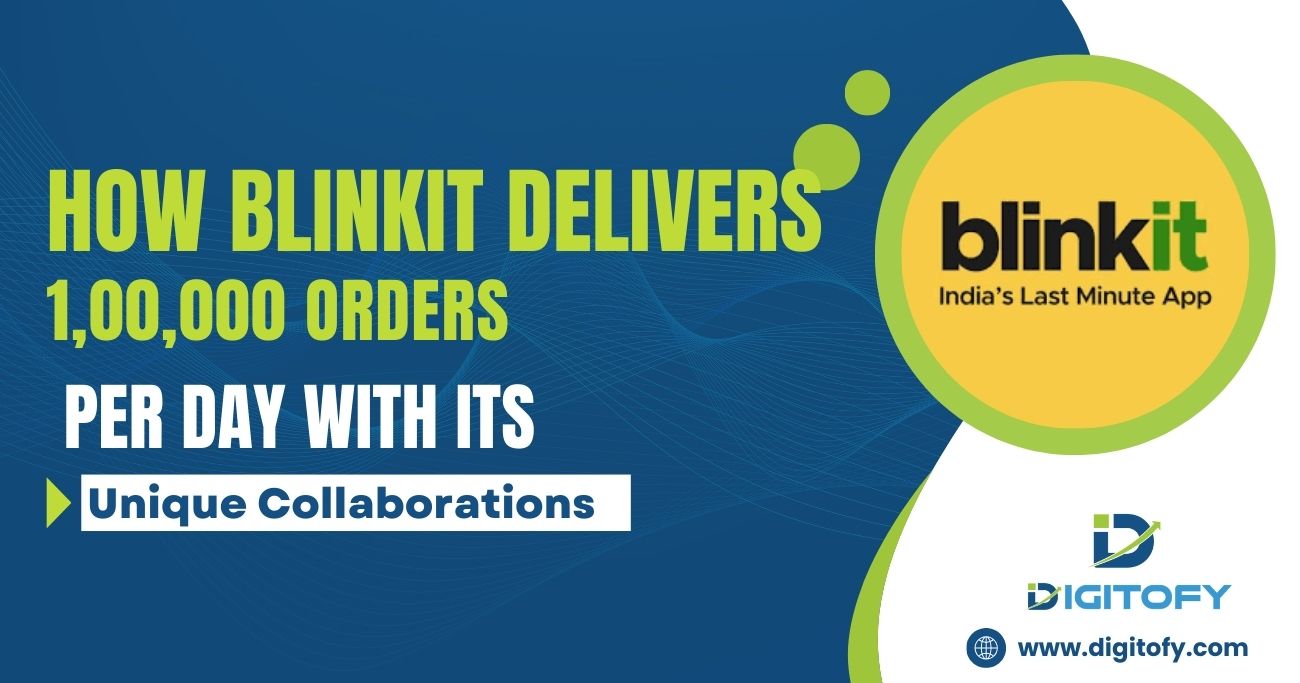Delivering Success: The Marketing Strategies Behind Blinkit’s Rise
Blinkit (formerly Grofers) has become one of India’s most talked-about startups thanks to its innovative approach to instant delivery. This article will analyze Blinkit’s marketing strategies and how they have fueled its rapid growth.
About Blinkit
Blinkit operates on the promise of delivering groceries and other daily essentials within 10-15 minutes. It was founded in 2015 as Grofers before rebranding to Blinkit in 2021. Backed by marquee investors like Softbank, Tiger Global, and Zomato, Blinkit is now valued at over $700 million.
From just 4 cities in 2015, Blinkit has expanded to over 20 major metro areas currently. Its asset-light model relies on tie-ups with third-party warehouses or shopkeeper networks for order processing. Blinkit’s delivery fleet leverages a mix of bikes and vans to achieve speedy drop-offs even in congested inner-city areas. This unique hyperlocal logistics model has catalyzed Blinkit’s rise to become a market leader in the quick commerce space within just 7 years
What’s New with Blinkit
Recently, Blinkit made waves by promising 10-minute deliveries for a wide assortment of products. This involved building out advanced supply chain infrastructure like micro-warehouses across cities. Blinkit also ran clever ads highlighting the convenience of near-instantaneous delivery.
Getting Personal: Understanding Blinkit’s Customers
Blinkit’s target audience is the time-pressed urban consumer looking to save on grocery runs. These buyers likely have higher disposable incomes but not enough time for supermarket visits. Blinkit’s messaging caters directly to their need for speed and convenience.
Crafting the Right Marketing Mix
An in-depth analysis of Blinkit’s marketing mix reveals how it has systematically crafted strategies across product, pricing, placement, and promotion to address consumer needs and fuel growth.
Product Strategy
While Blinkit offers groceries and daily essentials as its core range, its primary product is in effect ultra-fast delivery. Blinkit conveys the promise of lightning-fast fulfillment by continually tightening its delivery time SLAs, down to an ambitious 10 minutes currently. This positions instant availability, rather than range or discounts, as its key differentiator.
Assortment-wise, Blinkit stocks over 2,000 items across staples, snacks, beverages, personal care, and other categories. It curates its catalog based on local user preferences and high-frequency purchases. This hyper-localized approach ensures Blinkit carries items customers actually want, rather than wasting shelf space. Smaller centralized warehouses aid replenishment and inventory optimization.
Pricing Strategy
Blinkit maintains that its prices match those of large offline retailers. The goal is to nullify price as a factor and make rapid fulfillment the primary value proposition. This positions Blinkit as an on-demand convenience provider targeting time-poor, quality-conscious customers for whom convenience is more important than bargain hunting. It specifically rules out competing on price discounts like e-grocers.
Placement Strategy
Blinkit maximizes the reach advantage of its online-only model via an app-first approach. With dedicated apps for Android and iOS, it makes ordering incredibly seamless for digitally native consumers. App-exclusivity also enables precise user targeting and retention via offers and engagement features.
For order fulfillment, Blinkit operates numerous micro-warehouses inside dense city centers. Located strategically close to core catchment areas, these localized hubs allow super-quick deliveries, often by bike. This infrastructure supports Blinkit’s 10-minute SLA by minimizing last-mile transit times.
Promotions Strategy
In line with its app-first approach, Blinkit advertises primarily across digital channels like YouTube and social media. Recent campaigns highlight convenience and delivery speeds with catchy slogans like “Order in 10 seconds, get it in 10 minutes.” Such ads target the same time-pressed urban demographic that Blinkit’s business model is designed around.
Blinkit has also forged win-win partnerships with entertainment brands like Netflix. Joint campaigns tempt viewers to order snacks while watching shows, conveying Blinkit’s instant availability. Such contextual messaging helps drive preference among existing users and expands reach by acquiring new ones.
By analyzing key elements of its marketing mix, we can understand how Blinkit systematically crafts strategies tailored to customer convenience. This focus will continue fueling its ambitious growth trajectory in quick commerce.
Analyzing the Competition
Though the quick commerce sector is getting increasingly crowded, Blinkit’s early mover advantage and executional edge help it maintain leadership for now. Nonetheless, new entrants are fast catching up.
Key competitor Zepto is also prioritizing speed with plans to match Blinkit’s 10-minute delivery benchmark. Fueled by big funding rounds, Zepto is expanding rapidly across metro cities, even attracting senior talent from Blinkit. However, Blinkit’s headstart has allowed it to perfect complex supply chain logistics, making it tough to displace.
Swiggy’s Instamart is also growing at breakneck speed by leveraging Swiggy’s large fleet and consumer mindshare. However, Swiggy’s model of using external fulfillment locations can make it harder to achieve 10-15 minute delivery at scale. Blinkit’s own hyperlocal micro-warehouses have an edge here.
Ola has forayed into quick commerce with Ola Dash, though it’s still early days. International behemoths like Uber are also keen on the Indian market, attracted by forecasts of a $25 billion opportunity by 2025. While deep pockets can offset operational challenges, cracking Indian logistics requires specialized local experience which Blinkit capitalizes on.
By continually enhancing discounts and speed, these players aim to capture consumer mindshare. But Blinkit is far ahead in fine-tuning delivery logistics for density and scale. Its challenge is to preemptively plug gaps, improve unit economics, and consolidate its grip over prime locations. Maintaining breakaway speed and liquidity will be key to counter aggressive competition.
Spotlight on Blinkit’s Success Strategies
Behind Blinkit’s marketing success are strategies tailored specifically to solve India’s unique supply chain challenges.
- Leveraging Partnerships – Tie-ups with media platforms like Netflix have helped Blinkit engage consumers contextually. For instance, ads saying “Your Netflix binge starts in 20 mins, get the popcorn delivered in 10” convey instant availability ingeniously.
- Solving Small-Ticket Woes – Blinkit delivers even low-value orders that local kiranas would refuse. This captures impulsive purchases and builds loyalty among time-pressed city dwellers.
- Relentless Focus on Speed – By systematically removing delays at every step, Blinkit is able to reduce delivery times to just 10 minutes. This fanatical focus on speed sets it apart from competitors.
Conclusive words
Blinkit’s unique strategies have made 10-minute deliveries a reality in India. Its marketing success provides a template for other quick commerce businesses looking to make their mark. With smart segmentation, positioning, and sharp execution, Blinkit has demonstrated how to sell convenience to time-starved metro consumers.

.webp)

